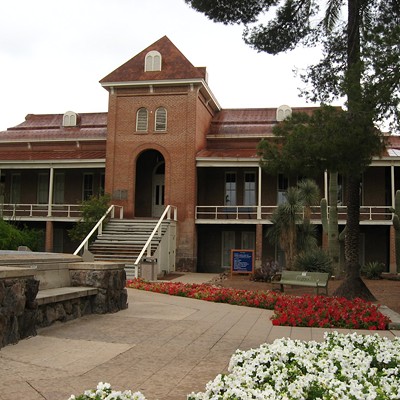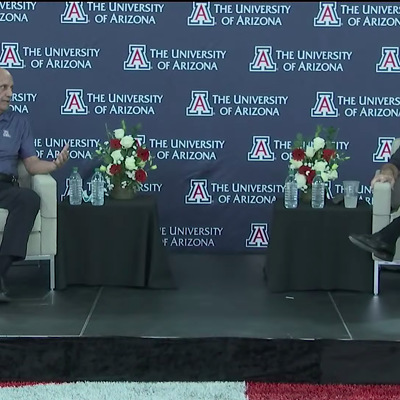But in these times of state education budget cuts, the UA could potentially end up spending millions cleaning up sensitive labs of some nasty materials.
The best example: the UA Nuclear Reactor Lab.
"Of course, it's all complicated by the fact that it's not the kind of laboratory you just shut down and turn off the lights," says UA Provost George Davis. "We have a federal policy mandate to do this correctly, and that's going to take investments of resources."
Shutting down the reactor means following the Nuclear Regulatory Commission guidelines for "decommissioning," defined by the NRC as: "The process of safely removing a facility from service followed by reducing residual radioactivity to a level that permits the release of the property for unrestricted and, under certain conditions, restricted use."
According to the UA's written statement: "Because of federal compliance and safety regulations, the full closure of the Nuclear Reactor Laboratory will require approximately 10 to 12 years."
Current estimates put the decommissioning bill at $1.5 million--if everything goes smoothly.
"It's very difficult to even estimate what the costs are going to be for the decommissioning; that's the next step," says Davis.
A decommissioning plan alone is estimated to cost $100,000, says Dr. John Williams, director of the nuclear reactor laboratory.
Dr. Melvin Young, director of the UA's Radiation Control Office, which is monitored by the Arizona Radiation Regulatory Agency and the Nuclear Regulatory Commission, says the bill will fall in the university's lap.
"It's certain the feds are not going to pay for it, so it's going to be something the university is going to have to figure out how to generate the money," he says.
They have some time, though: The license to operate the reactor expires in 2010, and that is the target date for closing the facility.
"In some ways, there's a window of time that seems generous," says Davis. "But right now, in the current state financial climate we think it's going to be really challenging to find a way to lay our hands on the amount of dollars we need to carry out decommissioning, but that's what we've challenged ourselves to do."
The north wing of the Engineering Building is home to the first General Atomics' TRIGA Mark I reactor in the nation installed in an educational institution. It was placed in the UA engineering basement in December 1958 and refueled in 1972.
UA's little 100 kilowatt reactor generates, at most 100,000 watts of energy. Compare that to the Palo Verde Nuclear Generating Station that operates three reactors, which together generate roughly 3.8 billion watts--enough power for about 4 million people.
Around the country, small university research nuclear reactors are used to educate students for nuclear-related careers in the power industry, national defense, health service industry, research and education. There are 36 research and test reactors licensed to operate in 23 states, with 12 research and test reactors currently being decommissioned.
Closing the UA nuclear reactor is not a new idea, though "Focused Excellence" has tagged it a priority.
The Nuclear Engineering undergraduate degree program was closed in 1998, and the graduate degrees continued through the Department of Aerospace and Mechanical Engineering. But between 1998 and 2001 (the last year courses were offered), only one master's degree and three doctorates were Given the low numbers of students and the safety compliance and liability responsibilities of the program, the decision to decommission was made.
"There are still graduate courses offered through the mechanical engineering department, but there are a certain number of students that have to sign up for a class before they actually have it," says reactor supervisor Mike Gavelek.
According to the NRC, 73 licensed research and test reactors have been decommissioned since 1958, most without a hitch. But when there have been hitches, they've been big.
"The University of Washington is certainly a horror story, but there is no reason to think it will be repeated and there are many other places where decommissioning is going much smoother," says Williams.
The University of Washington's 100 kilowatt reactor had been approved by the NRC for decommissioning 15 years ago, but the work drags on. While some of the dismantling work began in late 1988, a full decommission plan took until 1994 to be submitted to the NRC--a plan that was to be completed by 1999. Since the mid-1990s, the UW has repeatedly requested state funding to finish, with the current budget request chiming in at $4.6 million--above and beyond the original $1.2 million estimate.
"It was partly to do with an impasse between the NRC and the state of Washington's funding of it," says Williams.
One potential hold-up at the UA is that the reactor's fuel rods are owned by the Department of Energy, which dictates when they can be removed and shipped to Idaho Falls.
"The DOE has our fuel scheduled for shipment in 2012. Now, it's not impossible that schedule could change but there are limitations on what can be done because of the agreement with the state of Idaho," explains Williams.
"If we attempted to decommission before we have a home for the fuel, then we're left sitting guarding it."
That raises homeland security concerns, says Williams.
"The amount of radioactive material in the fuel is not enough to create a severe radiological hazard and so the reactor is perceived as a security 'issue' because it could be attractive politically."












